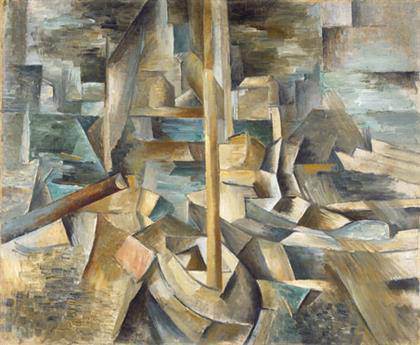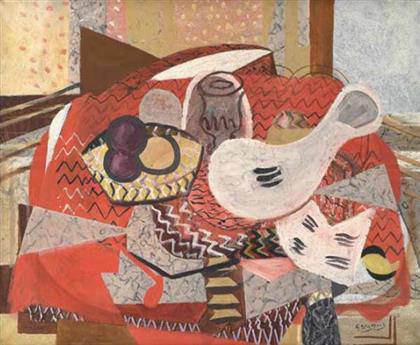
Georges Braque
The Port (Le Port), winter-spring 1909
Oil on canvas, 40.6 x 48.2 cm
Washington, National Gallery of Art,Gift of Victoria Nebecker Coberly in memory of her son, John W. Mudd
©Georges Braque, VEGAP, Bilbao, 2014
Photo © National Gallery of Art, Washington

Georges Braque
Still Life with Red Tablecloth (Nature morte à la nappe rouge), 1934
Oil on canvas, 81 x 101 cm
Private collection
©Georges Braque, VEGAP, Bilbao, 2014
Photo © Laurens / Leiris SAS Paris
Georges Braque retrospective at Guggenheim Bilbao On the occasion of the 50th anniversary of the artist’s death, Guggenheim Museum Bilbao hosts ‘Georges Braque’, the most ambitious retrospective held in Spain to date of the work of Georges Braque (1882–1963). June 13 – September 21, 2014.]]>
Source: Guggenheim Museum Bilbao
This chronological overview covers every period of his artistic career, from his early Fauvist phase to his final series dedicated to studios, birds, and the landscapes of Varengeville.
Thanks to generous loans from the Centre Georges Pompidou and other major international public and private collections, the show features nearly 250 pieces, including some of the greatest masterpieces by a man who, along with Picasso, laid the foundations of Cubism and invented the papiers collés or “pasted papers” collage technique. The exhibition, made possible by the remarkable sponsorship of Fundación BBVA, also takes a closer look at his still lifes (with their repeated use of the guéridon and fruit bowl motifs), his Canéphores , his postwar billiard tables, and the studios and birds produced towards the end of his life, which amplify and sum up his artistic research.
“Georges Braque” explores other fascinating perspectives as well, with a collection of rarely shown documents and photographs that offer a glimpse of the artist’s most personal side. Of particular interest is Braque’s collaboration with Pablo Picasso during the Cubist years, the resonance between his art and music (he played several instruments, including the accordion, flute, and violin), his friendship with composer Erik Satie, and his affinity with poets like Pierre Reverdy, Francis Ponge, and René Char and important intellectuals of his time such as Carl Einstein and Jean Paulhan. Finally, an important part of this retrospective is given over to exploring Braque’s work as a stage designer in the 1920s, with a unique installation design conceived exclusively for Frank Gehry’s building.
“Georges Braque” is a retrospective that aims to highlight this artist’s pivotal role in the history of art, the importance of which has often been underestimated. In the words of Brigitte Leal, curator of the show, “His status as the official artist of Gaullist France undoubtedly diminished his importance in the eyes of the reactionary generation that followed, condemning him to relative obscurity for several decades.” This exhibition offers unique insight into an exceptional artist whose motto, recorded in the diaries published as “Le Jour et la Nuit”, was, “One must not imitate what one seeks to create.”
Related content
Georges Braque retrospective at MFAH Houston (exhibition, 2014)
Follow us on:


